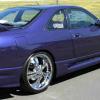Cooling Fans Pulling Air Through Intercooler.
Announcements
-
Similar Content
-
Latest Posts
-
Yeah they are mega expensive, but at least you get a bit more rubber for your money I don't know what you are running at the front now, but at the rear I would keep it at 1.5, you need the tyres to sit reasonably flat to get power down, I think you will find it loses grip too soon at 2.5 In the front, the amount of caster is more important. The r33 gtst we just did the race alignment for had only 1.5 camber on the front, but heaps of caster, it drives very nice.
-
Other than reproducing it, I very much doubt you'll find one, Do you have a pic of what you mean?
-
Just for shits and giggles here is some pics of the ramps on my old Nismo GT LSD
-
By Celticsfan03 · Posted
Hey everyone. Is there a way I can get the original window sticker (maroney label) for my 1995 R33 GTST? I doubt I’ll be able to ever get it but it’s worth a shot to ask
-






Recommended Posts
Create an account or sign in to comment
You need to be a member in order to leave a comment
Create an account
Sign up for a new account in our community. It's easy!
Register a new accountSign in
Already have an account? Sign in here.
Sign In Now